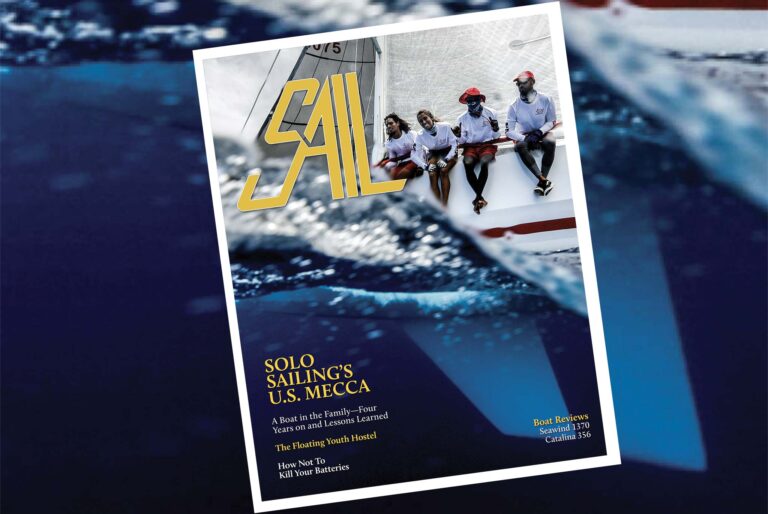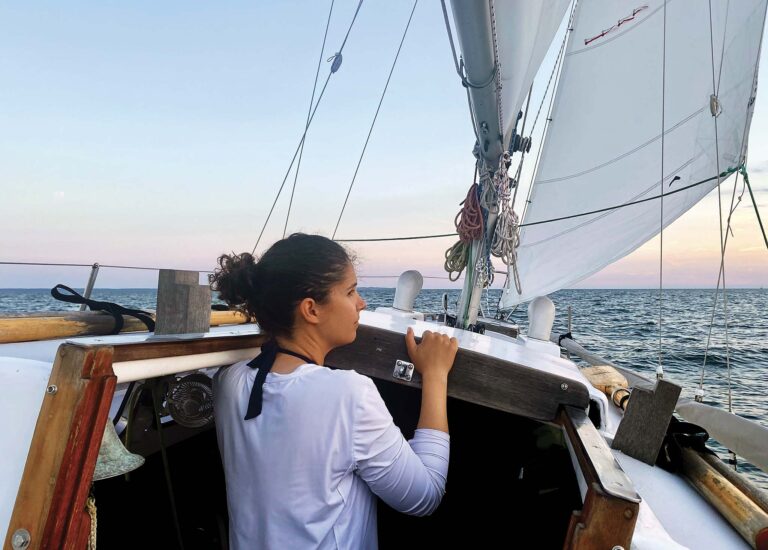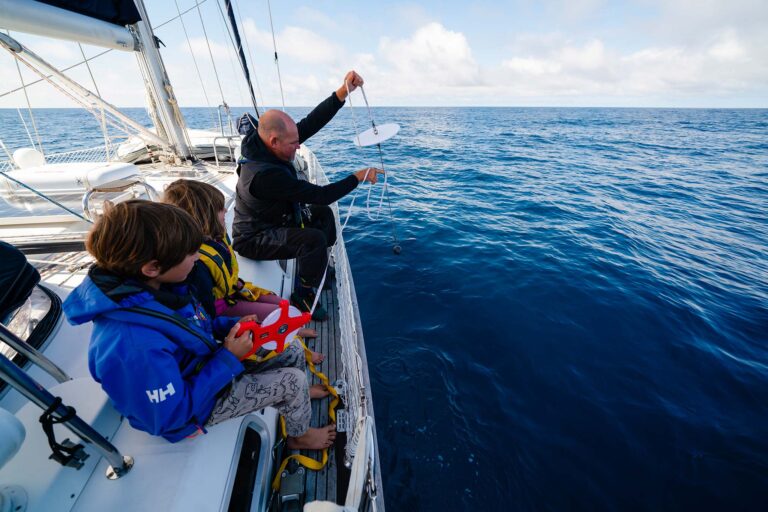
As far as fleets go, the collection of boats that greeted me as I motored into Hampton, Virginia, in late October was as varied as they come: sloops, cutters, catamarans, a trawler and even a trailer-sailer, all geared up and ready for an adventure. I had brought our Norlin 34, Ostara, down from Boston’s North Shore to join 20 other boats in SAIL’s second Snowbird Rally down the Intracoastal Waterway.
Always one to be fashionably late, ours was the last boat to arrive in Hampton for the rally start. I was waved into a slip at the Hampton public pier by a smiling Tom Hale, co-leader, along with On The Water Chartguides authors Mark and Diana Doyle, of the 2015 Snowbird rally.
The get-to-know-you dockside drinks party that afternoon was my first chance to get acquainted with the other rally participants. They looked a happy enough bunch, for sure; who wouldn’t be, heading south away from a northern winter? Ahead of us lay 800 miles of the ICW, and for all but a few of this diverse group it would be the first transit of this legendary waterway. Mine, too, so I was glad to have the Doyles’ expert guidance.

The point of the ICW rally is to transform what can be a long, lonely slog into a shared—and guided—adventure, a cruise-in-company down a beautiful waterway that’s all the more enjoyable if you’re absolved from the weight of mile-by-mile planning. Regular briefings would advise us how to deal with the next lot of opening bridges, tricky shoal areas, locks and whatever else we might encounter. We would congregate at a number of designated marinas and towns along the way, where red carpets would be rolled out and there would be food, cocktails and the congenial company of our fellow sailors. We’d be in constant contact via VHF. We would not get our hands held, but a helping hand would be there whenever it was needed. If we had engine or systems woes, former ABYC VP Tom Hale was on hand to provide on-point troubleshooting and the use of his Port Supply card. What could possibly go wrong?

The Atlantic Intracoastal is an intriguing mixture of narrow tidal rivers and cuts and wide-open bodies of water, festooned with fixed and opening bridges with the odd lock thrown in just for the hell of it. I had already unwillingly traversed a couple hundred miles of it by entering the Delaware Bay at Cape May, transiting the Chesapeake and Delaware Canal and then slogging down the Chesapeake Bay to Hampton. In front of us lay another 800 statute miles—you go by these rather than nautical miles on the ICW, which caused me some angst to begin with—through five states before we reached our final stop, St Augustine in Florida. (For a full itinerary, go to icw.sailmagazine.com/rally).
The Doyles had carefully scheduled the route to leave some wiggle room for bad weather and keep long motoring days to a minimum, while allowing for time to explore the appealing destinations en route. They had planned parties at marinas and festivities in conjunction with local tourism authorities. They had also cultivated a network of “harbor hosts,” local cruisers and Seven Seas Cruising Association members who would befriend the rallyers during the stopovers and help them out with transportation, sightseeing and so on. It was a masterpiece of logistical planning, and, amazingly considering a bunch of sailors were involved, it all held together.

I was struck by the fact that while I can contemplate an open-water passage of several hundred miles with equinamity, the prospect of entering the confined waters of the ICW caused me no little anxiety. At the same time, I had always been intrigued by descriptions and photos of the Great Dismal Swamp Canal, so on the rally’s first morning, when Mark gave me the choice between accompanying the fleet through the Canal or taking the Virginia Cut route favored by deeper-draft vessels, it was the Dismal Swamp for me, and damn the torpedoes. After all, at least one other rally boat drew 6ft, which is the canal’s controlling depth.

Although we touched bottom many times along the 22-mile canal (as did other boats that drew less than us), it was an experience I wouldn’t have missed. Maples, cypress, gum trees and juniper crowded the banks and branches reached out toward our masthead gear as we tried to keep bang in the middle, tracking down the strip of sky reflected between the treetops in the inky, tannin-infused water. Our steady 5.5 knot speed slowed by half a knot from time to time as the keel dug a fresh furrow through the soft bottom. Late that afternoon it became clear we wouldn’t reach the Dismal Swamp Welcome Center before dark, so we tied up to a handy government dock—ignoring the “Strictly No Mooring” sign—fired up the grill, opened a bottle of cabernet and enjoyed an eerily quiet (though freezing cold) night. It was almost surreal to think that just a few days earlier I had been on the receiving end of a thorough butt-kicking on the offshore delivery from New England. Next day, the presentation at the welcome center by lock-keeper/bridge tender Robert Peek was a real highlight of the trip.
My part in this ICW adventure came to end in Oriental, where I laid Ostara up for the winter. Meanwhile, I‘d enjoyed getting to know the rally folks during the Dismal Swamp, Dowry Creek and Oriental stopovers. Like most congregations of sailors, they were a thoroughly nice bunch with varying degrees of experience, enjoying their latest adventure. For some, the trip down the ICW was the first step in a new liveaboard lifestyle; for others, just one leg of an extended sabbatical or vacation.
There was an interesting cross-section of boats, too; Gil and Charlene Gelineau’s Bristol 45 Ithaka was the biggest, and, with her 64ft air draft, tempting fate with the ICW’s 65ft bridge clearances. At the other end of the spectrum was Il Nostro Sogno, Kirk Nilles’s and Melba Covert’s MacGregor 26, a very well-travelled boat whose exploits you’ll read about in a future issue of SAIL. In between, many of America’s past and present boatbuilders were represented; Tartan, Catalina, Caliber, Gemini, Pacific Seacraft, Island Packet, Hunter, Passport, Freedom. In a sign of the times, a quarter of the fleet was comprised of catamarans. Retired public defender Steve Spracher, single-handing his Lagoon 38 Southern Cross, was the most seasoned sailor on the rally. Steve is a veteran of some hardcore bluewater sailing and several open-water rallies, including the World ARC; a gregarious fellow for a solo sailor, he just happens to love the social side of the rally experience. It’s a great way to not just meet people, but to form lasting friendships through shared experiences.

And yet, there’s more to this rallying game: Donna Schlachmann and Rob Becker, who sailed their Hunter 38 Kinship south from New Hampshire in company with the Gelineaus on Ithaka, joined up at the last minute after a hard few weeks of cruising south: “We feel incredibly lucky to have fallen in with this lot at Hampton … The chance to have others help make decisions, give advice and provide a high level of ICW expertise was just what we needed at that time,” Donna says.
“It’s an overworn phrase, but the rally is the gift that keeps on giving. We continually use the knowledge imparted, we know better what questions to ask ourselves, and we know where to look for answers. Our leaders were top-notch and we just feel plain lucky to have shared some of the ICW with them.”

The Snowbird Rally wound up with SAIL’s Sailing South seminar in St. Augustine, which drew more than 100 cruisers to enjoy presentations on sailing to Cuba, the Bahamas, the Caribbean and the Florida Keys and Dry Tortugas—which represented the spread of the rally alumnis’ aspirations. Some went east, others south; as one adventure ended, others began.

The Route
After Hampton, the rally left Virginia and entered North Carolina via the Dismal Swamp Canal. The fleet spent two nights at Elizabeth City, then crossed the Albemarle Sound and Alligator River to Dowry Creek Marina at Belhaven. Next port of call was Oriental, and after that Spooners Creek Marina in Beaufort, followed by Southport Marina in Southport.
In South Carolina, the rally stopped over at Osprey Marina in Myrtle Beach, Charleston Harbor Marina in Charleston, and finally the Downtown Marina in Beaufort.
In Georgia, the first stopover was in Savannah Bend Marina in Thunderbolt, outside Savannah. The next was at Golden Isles Marina on St. Simons Island, followed by Lang’s Marina in St. Marys on Cumberland Island. On the Georgia/Florida border, Fernandina Beach Marina was the last stopover before the rally wound up in St. Augustine.
EXPERIENCE THE ICW WITH SAIL
We’ll be announcing details of the 2016 Snowbird Rally in the next month or so. The third Secrets of the ICW seminar will take place on Sunday, October 9, in Annapolis. Keep an eye on icw.sailmagazine.com for sign-up information.
March 2016









